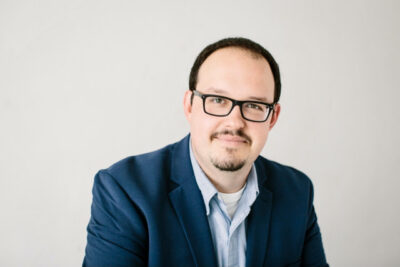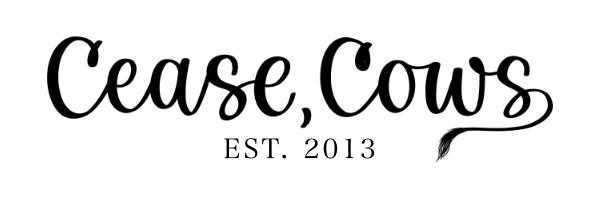As Halloween approaches, readers often look for stories of the odd and unreal, and this year Bradley Sides is here to help! Sides’ new collection, Those Fantastic Lives and Other Strange Stories, is bold, unsettling, and always entertaining. Anyone seeking a quick trip into the unexpected will savor these tales.
Purchase your copy here.
Sides recently shared his thoughts with Cease, Cows.
Chuck Augello: How would you describe your work to someone who has never read any of your stories yet?
Bradley Sides: My work is about loss and loneliness, largely. I know that sounds dark, but I’m not interested in only examining these issues with a doom and gloom perspective. There can be love in loss. There can be comfort in loneliness. I think many of my stories, too, tend to be focused around outsiders and how these characters search for their individual truths and places.
Also, my stories heavily rely on the fantastic. I see the world as being this big, weird place that has many mysteries. For me, having monsters, aliens, ghosts, and kids with wings in my stories helps me approach the world as I actually see it—again, really weirdly—in a more truthful way.
CA: One of my favorite stories in the collection is “Dolls for the End of the World”, which opens with the intriguing line: “There was no way to guess what the world would become.” The key relationship in the story is between a boy and his doll. What was the initial inspiration for this story?
BS: I’m so glad you like “Dolls for the End of the World.” It’s one of my favorites as well. So, I’ve been haunted by a creepy doll for many years. On holidays, my cousins and I fix our plates and then eat in my mother’s basement. It’s just how it’s been for as long as I can remember. Anyhow, whenever anyone opens the door to go down into the basement, there, staring back as the light switches on, is this pink doll with a head that spins. My mother keeps it for decorations, I guess. The doll always gets comments. Always. I think about it often, but when I wrote this story, I was thinking about how lonely it must get in the dark, when no one is around. How it would probably like a journey. How it might even come to life and be a part of a journey. How it scares people, but how it might also save people if given the chance.
CA: The book’s subtitle, “And Other Strange Stories” is certainly truth in advertising. What attracts you to writing stories that flirt with different worlds and the unreal?
BS: I’m a very quiet person, and I also like the quiet. Give me some insects softly chirping or a fan that’s humming, and I’m at peace. The quietness gives me a chance to imagine. To get lost. To think of what-ifs. I’ve always been curious about those sounds I hear that I can’t quite place and the shadows, out of the corner of my eye, that dance against the wall. I was one of those kids who looked up at the clouds and saw monsters and everything else. I think I’m that adult, too. The unreal is real to me, if that makes sense. Writing about those things we can’t ever know gives them a realness that I crave—a realness that makes me feel more, well, real.
CA: Henry and Ollie, the brothers in “The Comet Seekers,” are two of your most memorable characters. Several stories feature children as protagonists. What draws you toward writing about children, and what are some of the challenges in creating such characters?
BS: I work with young people, so I’m in that world for a big chunk of my life. Also, I started writing these stories when I was approaching my mid-twenties. I was reflecting on what it was like to leave childhood behind and fully embrace adulthood. By giving voice to young characters who are confused by adults and the world as a whole, I think I was able to extend my own internal reflections, in ways.
Society sometimes seems to view the young experience as being less than. Less responsibility. Less stakes. Less difficulties. I don’t buy into that. Childhood is difficult, confusing, and very, very complex. In stories where I’m exploring childhood, I spend a lot of time to make sure I respect my characters’ experience—to make sure what I capture is real and truthful.
CA: “A Complicated Correspondence” is written as an email exchange between two characters. What attracted you to that mode of storytelling?
BS: Although I’ve recently been trying out some different formatting styles for what I plan to be my next collection of stories, the stories in Those Fantastic Lives are much more traditional in structure. I do have a before and after story, and there’s a numbered one, but “A Complicated Correspondence,” which is about werewolf best friends who have very different families and ways of dealing with hardships, is the one that really embraces a different form the most. It comes about halfway in the book, and it’s after some pretty heavy stories. I thought the form would give some looseness and that it would also give the story, which still packs an emotional punch, a feeling of fun.
CA: We both have connections to the MFA Program at Queens University of Charlotte. How has being in an MFA Program influenced your work?
BS: Being at Queens has been one of the greatest gifts of my writing life, and I full-heartedly mean that. While there, I’ve found a community that’s full of respect and support. I’ve learned how to be a better writer, reader, and editor. I’ve been inspired by the talent I’ve seen. I’ve been grateful for the guidance from the faculty—and especially from Fred Leebron, Elissa Schappell, and Naeem Murr. The whole thing has been everything I’d hoped for and much, much more. It’s influenced me in so many ways that it’s hard to imagine the before…
CA: If you could go back in time and tell your younger self one thing that you’ve learned about yourself as a writer, what would it be?
BS: “Don’t be scared to write weird stuff. You are weird. Be you.”
CA: Who are some of the authors whose work excites you?
BS: I’m excited by so many authors. Consistently, too. I love Matt Bell’s allegorical work, Aimee Bender’s opening sentences, Becky Hagenston’s bizarre worlds. Another writer I’m excited by is Mike Flanagan. His work in the television world is full of pain and loss, and the way he captures what it’s like to be haunted is unlike anything I’ve ever read or seen. The Haunting of Hill House and The Haunting of Bly Manor, which are obviously adapted from great source material, are both masterworks. I always look forward to seeing what he’ll do next.
CA: Finally, there’s no shortage of ways to spend one’s time. Why do you choose to write fiction?
BS: I write fiction because it’s the only way I can ever even attempt to understand myself and my place in this weird world.

–
Chuck Augello (Contributing Editor) lives in New Jersey with his wife, dog, two cats, and several cows that refuse to cease. His work has appeared in One Story, Juked, Hobart, SmokeLong Quarterly, and other fine places. He publishes The Daily Vonnegut and contributes interviews to The Review Review.
Bradley Sides‘ writing appears in Chapter 16, Chicago Review of Books, Electric Literature, Los Angeles Review of Books, The Millions, The Rumpus, and Southern Review of Books. He holds an MA from the University of North Alabama and is an MFA candidate at Queens University of Charlotte, where he serves as Fiction Editor of Qu. He lives in Florence, Alabama, with his wife, and he can be found on most days teaching creative writing and English in southern Tennessee. Those Fantastic Lives is his debut.

